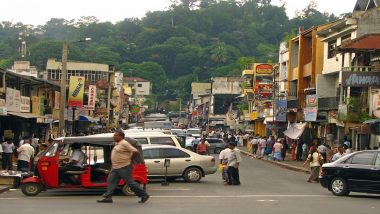The government of Sri Lanka has imposed a 10 day state of emergency in the island nation following days of anti-Muslim violence in its central region of Kandy. The violence has taken two lives, along with burning down four mosques, 37 houses, 46 shops and 35 vehicles damaged in Digana and Teldeniya areas. This is the first time in seven years that a state of emergency has been imposed in Sri Lanka. The country was under a state of emergency for nearly 30 years during the time of LTTE insurgency.
The Prime Minister Ranil Wickremesinghe has promised action against those rioting and inciting violence. In a speech given to parliament, he has accused extremist elements from outside the Kandy region for causing violence, "Buddhist and the Islamic clergy in Digana and Theldeniya were engaged in a dialogue to resolve the issue peacefully but a group of extremists who had come from outside were the culprits who were engaged in violence." A police spokesman said hundreds of commandos from the police Special Task Force had been deployed to the troubled district to restore order and enforce the curfew.
The sequence of the outbreak of violence in Kandy is a build-up of mistrust between the majority Thervada Buddhist population which comprise of almost 75% of the country’s population and Tamil Muslims which comprise of 10% of the island’s population.
What Led To The Violence?
The most immediate cause of the outbreak of violence is the death of a Buddhist truck driver after an altercation with a group of Muslim youth in Kandy. Reports suggest that during his funeral procession, passions were ignited and a communal colour lent to the death which was prima facie a road rage incident.
Observers report that the family of the victim were compensated and the matter had been amicably settled with the involvement of local Muslim and Buddhist clergy and the family of the victim with the assailants in police custody. But Buddhist extremist elements seized upon this chance to act against a perceived religious killing to enact vengeance on Muslims of the area. As shops, houses and mosques were burnt down a Muslim youth’s body was recovered from one of the gutted houses. The scale of the rioting and burning down of property is according to witnesses on par with the anti-Muslim violence that took place in Alutgama in 2014.
Is There A History of Sinhala Buddhist-Muslim Enmity Before 2014?
The only previous incident of anti-Muslim violence happened a century ago in 1915 in British-Ceylon. The rise of a Buddhist identity and its revival manifested itself in the marginalization of Hindu Tamils which led to the formation of LTTE. Originally, majority of Muslims, most of whom are businessmen or traders were was part of the LTTE’s Eelam vision.
Until 1990, the Muslims believed they had common cause with Tamil political aspirations. But that year, a newly resurgent LTTE following the IPKF’s departure from Sri Lanka, drove out nearly 100,000 Muslims overnight from their northern citadel of Jaffna and other parts of northern Sri Lanka under its control. That was when the Sri Lankan Muslim found a new political consciousness, and within a decade of its formation, the Sri Lanka Muslim Congress was seen by Sinhala political parties as a “kingmaker”. It is currently part of the ruling coalition in Sri Lanka.
As the LTTE insurgency was defeated and Hindu Tamils became an even more marginalized group, Muslims in Sri Lanka forged their own identity. But with time and a changing global landscape, the politics inside Sri Lanka changed too.
Militant Buddhism
The war in the country has given rise to a militant form of Buddhism and the original group calls itself Bodhu Bala Sena. The Bodu Bala Sena or BBS - translated as "Buddhist Power Force" - is a Sinhala Buddhist monastic organization which promotes hardline Sinhala extremist views. Its offshoots like Maha Sohon Balakaya were reported to be seen in violence-hit areas of Kandy. These groups have been involved in a number of campaigns against issues such as halal certification, family planning, birth control, Christian conversion among others.
2014 saw the first large-scale anti-Muslim violence in Sri Lanka which killed four people and at least 50 houses were burnt down along with other property. These riots were for the first time identified with an extremist form of Buddhism. This is especially relevant as the way Muslims practice Islam has changed to in the island nation.
Island Muslims like many in South Asia, conformed to a Sufi Islam that followed preachers, believed in different cultures and inter-mingled with Buddhist life. This changed as Wahhabi Islam, an ultra-conservative form of practicing Islam reached Sri Lanka in the late 1990s - early 2000s. A significant influx of Wahhabi preachers and activists from south India and Saudi Arabia changed the way Islam was practice and interacted with other religions. As Muslims became more conservative, Buddhist elements saw this as a threat to their island.
Hence, the violence in 2018 includes elements of continued distrust between the two-communities. Even before the death of the truck driver, rumours had it that some eateries owned by Muslims were adding a chemical substance or a pill in the food they served to Buddhist customers to make them impotent. This "information" went well with the stereotype of the Muslim population growth rate theory in Sri Lanka.
The Extremist Buddhism-link Between Sri Lanka and Myanmar
It is interesting to note that the violence against Buddhists in Sri Lanka happening today coincide with the action against Rohingya Muslims in Myanmar. Myanmar too is a Buddhist country and follows Thervada Buddhism. Bodhu Bala Sena has previously invited the head of an extremist Buddhist organization in Myanmar to the island. The violence against Muslims previously too had coincided with riots in both countries in 2014. Another recent incident links the two countries. Sri Lankan Navy rescued a group of Rohingya Muslisms from a boat in the Bay of Bengal and housed them in United Nations Human Rights Commission protected safe house on the island. This incident had drawn protest from island Buddhists and according to Nationalist Buddhist groups is another example of religious minorities wielding undue political and economic influence on the island.
After a century of no violence, the recent incidents show the increasing frequency of public clashes between Island Muslims and Buddhists. As the government, works to restore normalcy in the region unless Nationalist Buddhist groups and Muslims leaders sit down to reduce distrust among the two communities, incidences of sectarian clashes will only become a more common feature of Sri Lanka.
(The above story first appeared on LatestLY on Mar 07, 2018 06:46 AM IST. For more news and updates on politics, world, sports, entertainment and lifestyle, log on to our website latestly.com).













 Quickly
Quickly












